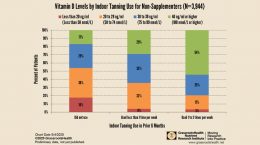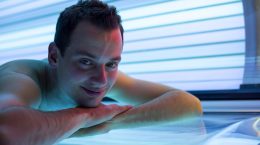Published on May 29, 2019
 Sunlight and supplements are well known sources of vitamin D, but other sources of UV light, such as indoor tanning, can also effectively raise vitamin D levels. In addition to sun exposure habits, we also ask our D*action participants about their use of indoor tanning. Participants are asked how often they have used indoor tanning equipment in the prior 6 months. The chart below summarizes the vitamin D levels among participants who reported not using vitamin D supplements according to indoor tanning frequency.
Sunlight and supplements are well known sources of vitamin D, but other sources of UV light, such as indoor tanning, can also effectively raise vitamin D levels. In addition to sun exposure habits, we also ask our D*action participants about their use of indoor tanning. Participants are asked how often they have used indoor tanning equipment in the prior 6 months. The chart below summarizes the vitamin D levels among participants who reported not using vitamin D supplements according to indoor tanning frequency.
The average vitamin D level was 41 ng/ml (102 nmol/L) for those who regularly used indoor tanning, 34 ng/ml (85 nmol/L) for infrequent users, and 28 ng/ml (70 nmol/L) for non-users. More than half of regular users (55%) had a vitamin D level at or above 40 ng/ml (100 nmol/L) compared to 31% of infrequent users and 17% of non-users. Only 3% of regular users had vitamin D levels less than 20 ng/ml (50 nmol/L) compared to 5% of infrequent users and 18% of non-users.
These results show that indoor tanning could be used to achieve a vitamin D level at or above 40 ng/ml (100 nmol/L), but that consistency is important. As with sun exposure, it is also important to be mindful of duration with indoor tanning and not burn.
Are you using UV or sun exposure as a source of vitamin D?
Is UV or sun exposure helping to improve your vitamin D level? Make sure you know your vitamin D level, and see if you are in the target range of 40-60 ng/ml (100-150 nmol/L). Find out your levels today! Log on to the shop (click the link below) to get your tests and see for yourself if your levels can be improved. Use coupon code SunMonth to receive 15% off during Sunshine Month only!
Make sure you track your results before and after, about every 6 months!
How can I track my UV, sun exposure and my vitamin D levels?
To help you track your UV and sun exposure and vitamin D levels, GrassrootsHealth has created an online tracking system called myData-myAnswers. You can also track your dietary intake and supplement use to see how both sun exposure and vitamin D from food and supplements impact your vitamin D levels and your health. Check it out today!







